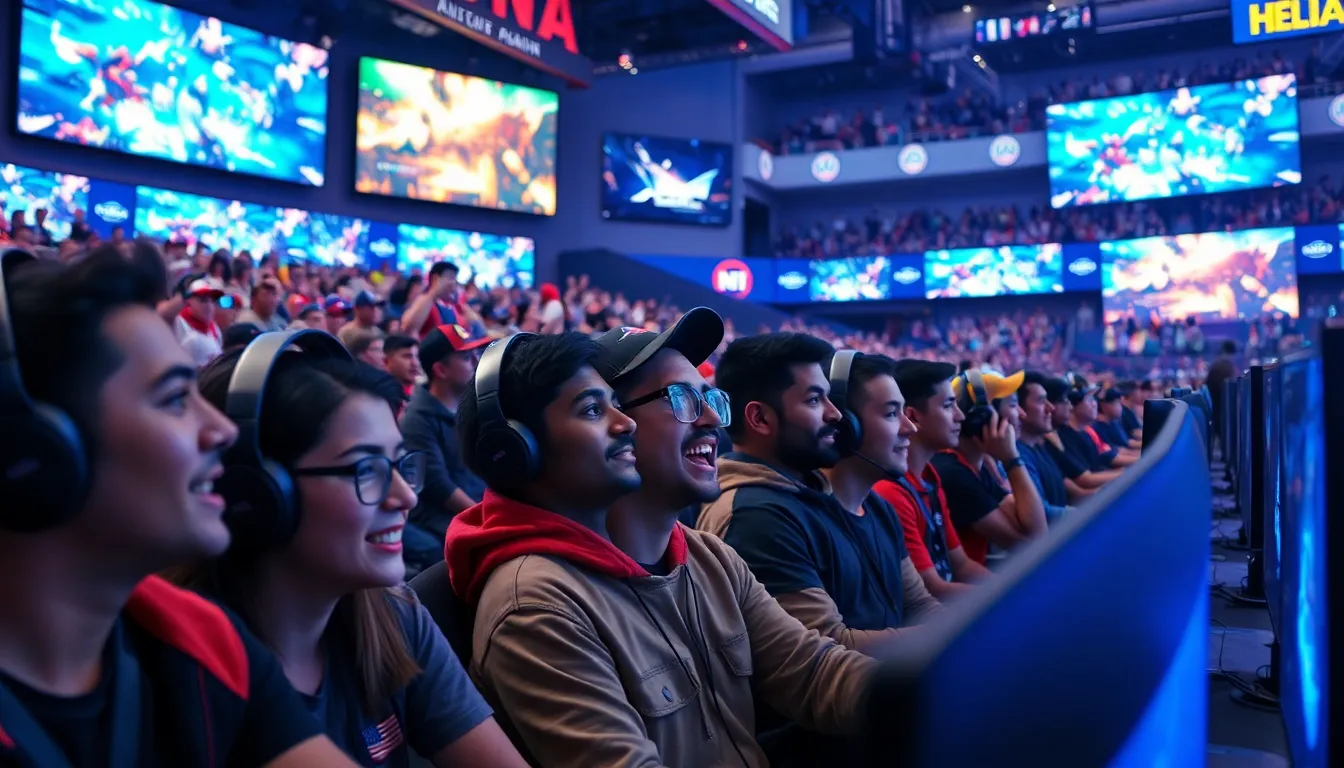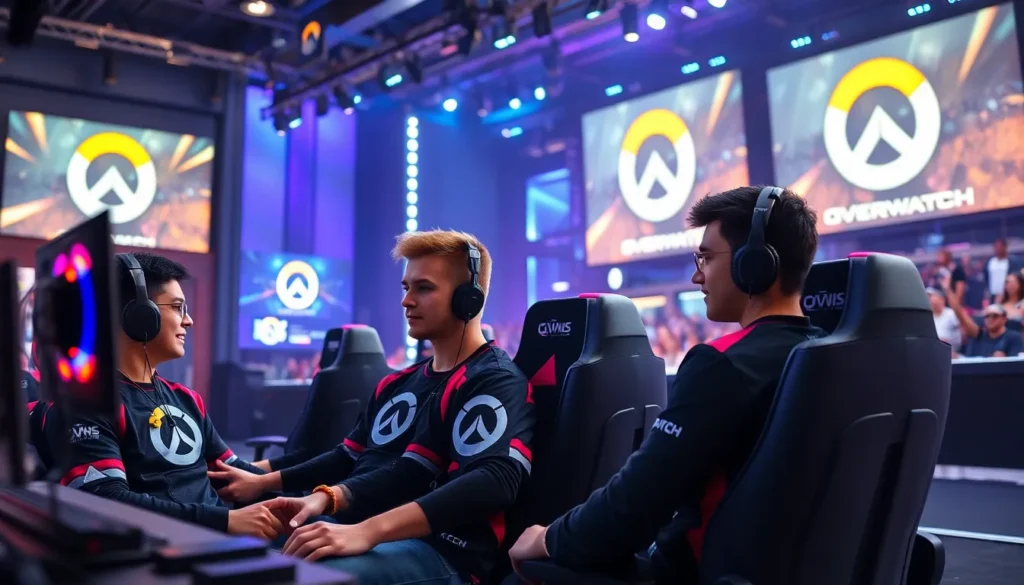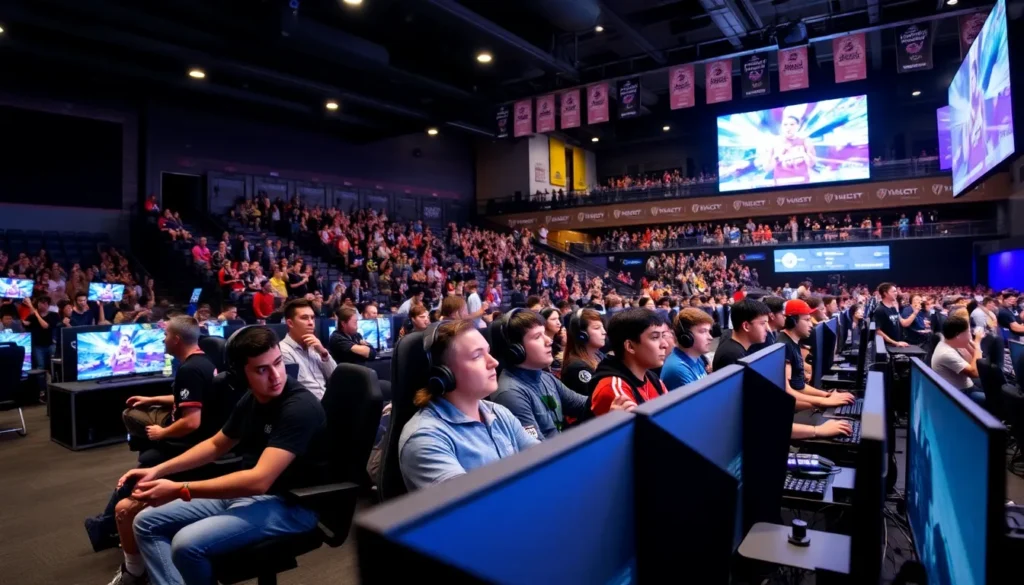Table of Contents
ToggleThe esports community has exploded in popularity, transforming gaming from a solitary pastime into a vibrant social phenomenon. Millions of players and fans connect through online platforms, forming a diverse ecosystem that spans the globe. From casual gamers to professional athletes, this community thrives on competition, collaboration, and shared passion.
As esports continues to gain traction, it’s not just about the games themselves; it’s about the culture that surrounds them. Tournaments draw massive audiences, while live streams create real-time interactions between players and fans. This dynamic environment fosters a sense of belonging and camaraderie, making the esports community a unique space where anyone can find their niche.
Overview of Esports Community
The esports community represents a dynamic, interconnected network of players, fans, and stakeholders involved in competitive gaming. Millions of individuals participate in various roles, from professional players to casual gamers, creating a vast ecosystem that thrives on shared interests and passions.
Tournaments serve as a focal point for engagement. Major events, such as The International and League of Legends World Championship, draw massive viewership, with audiences often exceeding several million spectators. These tournaments feature live gameplay and interactive elements that encourage fan participation, enhancing the overall experience.
Live streaming platforms, like Twitch and YouTube Gaming, play a pivotal role in community engagement. They facilitate real-time interactions, allowing viewers to connect with players through comments or chat features. This immediate feedback fosters a sense of belonging, as fans cheer for their favorite teams and players.
The cultural impact of esports extends beyond gaming. The community embraces diversity, with participants from various backgrounds sharing experiences and forming connections. This inclusivity contributes to a rich cultural tapestry that reflects the global nature of esports.
Sponsorships and partnerships with major brands underscore the economic significance of the community. Collaborations with game developers, hardware manufacturers, and beverage companies enhance the professional landscape. These alliances provide financial support and help elevate esports to mainstream recognition.
The esports community continues evolving, driven by technological advancements and changing social dynamics. New game releases and innovative gameplay formats refresh interest, while platforms adapt to meet users’ engagement needs.
Growth of Esports Community

The esports community experiences significant growth, exhibiting trends in popularity and global outreach. This expansion shapes the competitive gaming landscape and solidifies its position as a key player in entertainment.
Rising Popularity
Rising popularity characterizes the esports community, marked by increasing player participation and audience engagement. In 2023, an estimated 496 million people engaged with esports, emphasizing the genre’s rapid ascent. Major franchises, such as “League of Legends” and “Fortnite,” attract millions of new players and viewers each year. High-stakes tournaments featuring multi-million dollar prize pools further boost engagement, with events like The International and the Fortnite World Cup consistently breaking viewership records. The involvement of mainstream media further amplifies exposure, introducing esports to wider audiences through dedicated coverage and programming.
Global Reach
Global reach of the esports community showcases its profound cultural impact and demographics. Players and fans span continents, with major tournaments hosting participants from over 80 countries. Different regions exhibit unique gaming preferences, often translating into diverse tournament formats and styles. Moreover, esports transcends language barriers through international competitions, uniting players and fans under shared passions. Live streaming platforms serve as common hubs for global interaction, allowing audiences to connect with their favorite games and competitors in real-time. The community continues expanding its global footprint, attracting sponsorship deals and partnerships that enhance its visibility and acceptance across various markets.
Key Components of Esports Community
The esports community thrives on interconnected elements that enhance engagement and participation. These components include players, teams, fans, and the overall viewership landscape.
Players and Teams
Players and teams form the backbone of the esports community. Professional gamers often represent organizations, creating a sense of identity and loyalty among fans. Many organizations field multiple teams across various games, fostering competition within and between teams. Training regimens and coaching staff support player development, enhancing skill and teamwork. For instance, organizations like Team Liquid and Fnatic have garnered extensive followings, showcasing talent in titles such as “Counter-Strike” and “Dota 2.” Tournament participation enables players to showcase their skills on prominent stages, contributing to their careers through prize money and sponsorships.
Fans and Viewership
Fans and viewership significantly impact the esports community’s growth. Millions of fans engage with tournaments via live streams on platforms like Twitch and YouTube Gaming. These platforms enable real-time interaction between viewers and players, creating a vibrant atmosphere during competitions. Fans contribute to the community by participating in discussions, sharing content, and supporting their favorite teams through merchandise purchases. Major events attract large audiences, with viewership numbers often surpassing traditional sports events. For example, the League of Legends World Championship 2022 reached over 73 million concurrent viewers. The blend of technological advancements and passionate fan bases continues to drive the expansion of the esports ecosystem.
Impact of Esports Community
The esports community significantly influences social dynamics and economic trends. Its scope extends beyond gameplay, fostering connections and driving financial growth within various sectors.
Social Interaction
Social interaction thrives in the esports community, facilitating connections among millions of participants. Online platforms allow players and fans to engage through live streaming, social media, and forums. Platforms like Discord and Reddit enable community discussions, promoting collaboration and shared experiences. Esports events, both online and offline, gather diverse audiences, fostering friendships across geographic boundaries. Tournaments generate communal excitement, with fans uniting to celebrate their favorite teams. This sense of belonging enhances mental well-being, providing support networks for individuals across different backgrounds.
Economic Factors
The economic impact of the esports community is substantial, driven by increasing sponsorships, merchandise sales, and media rights. The global esports market is projected to reach $3 billion by 2025. Sponsorship deals with major brands like Intel and Red Bull further amplify financial investments, enhancing tournament prize pools and player salaries. Organizations such as Team Liquid and Fnatic secure lucrative partnerships that broaden their reach and influence. Merchandise sales, including apparel and gaming accessories, create additional revenue streams for teams and players. Moreover, advertising on streaming platforms generates significant income, capitalizing on large viewer bases. This economic ecosystem continues evolving, attracting investors and creating career opportunities in gaming, marketing, and event management.
Future of Esports Community
The future of the esports community looks promising, characterized by significant growth and innovation. Advancements in technology, including augmented reality (AR) and virtual reality (VR), are expected to enhance gameplay experiences, making interactions more immersive. New genres of games will likely emerge, attracting diverse audiences and expanding participation.
Increased investment from traditional sports organizations will further elevate esports’ profile. These partnerships can lead to more lucrative deals and the introduction of professional leagues, creating structured environments for competition. For instance, collaboration between the NBA and esports through the NBA 2K League demonstrates potential pathways for mainstream acceptance.
Educational institutions are integrating esports programs into their curricula, emphasizing its relevance as a career path. Colleges and universities across the United States are establishing varsity teams, providing scholarships and fostering talent development in gaming.
Diversity and inclusivity remain focal points for the esports community’s evolution. Initiatives aimed at promoting representation for underrepresented groups will create a more vibrant atmosphere. Female gamers and players from various backgrounds will play crucial roles in shaping the community, influencing game development and participation.
Moreover, regulatory frameworks aimed at ensuring fair play and player welfare are on the rise. Organizations are beginning to establish standards to protect players from harassment and ensure mental health resources are available, fostering a safer space for all participants.
As live streaming continues to dominate engagement, platforms may introduce new features that enhance viewer interactions. Features like real-time polling and audience participation in gameplay can boost fan investment, making fans pivotal in shaping game narratives.
Sponsorships are projected to increase, further validating esports as a legitimate entertainment medium. Global brands recognize the expansive reach of the community, investing in collaborations that promote engagement and drive viewership. This trend will likely result in higher tournament prize pools and increased media rights sales.
Emerging markets in Asia, Latin America, and Africa present new opportunities for growth. Local tournaments and grassroots organizations are paving the way for increased participation and viewership. Leveraging mobile gaming’s popularity, the esports community can tap into vast audiences across these regions.
Collectively, these factors indicate a vibrant future for the esports community, with online interactions, competitive structures, and inclusivity shaping its ongoing evolution.
The esports community stands at a thrilling crossroads of growth and innovation. With its diverse and inclusive nature it fosters connections that transcend borders. As technology evolves and traditional sports organizations invest more heavily the community’s reach will only expand.
Emerging markets and new platforms promise to introduce esports to even broader audiences. The commitment to player welfare and fair play will ensure a safe environment for all participants. As fans continue to engage through interactive experiences they will shape the future narratives of their favorite games.
With its vibrant ecosystem the esports community is poised to remain a significant player in the entertainment landscape for years to come. The journey ahead is filled with opportunities for players fans and stakeholders alike.







